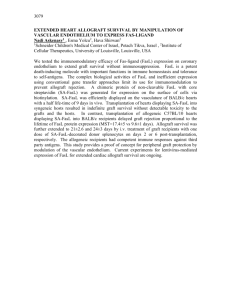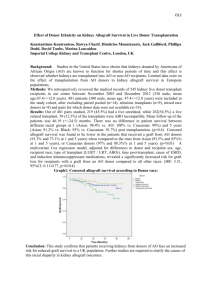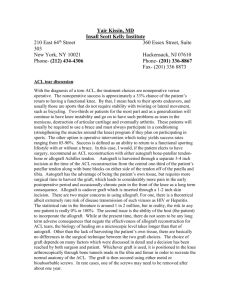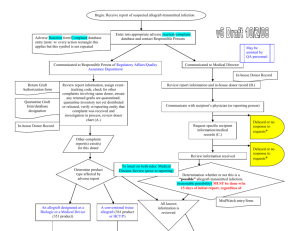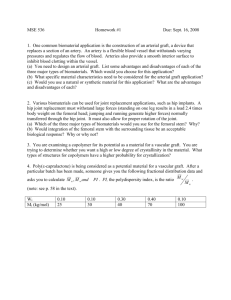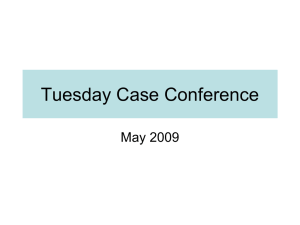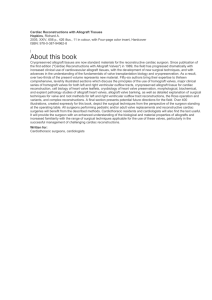Renal transplant failure فشل الكلي المنقولة Nahed Hammam Osman
advertisement
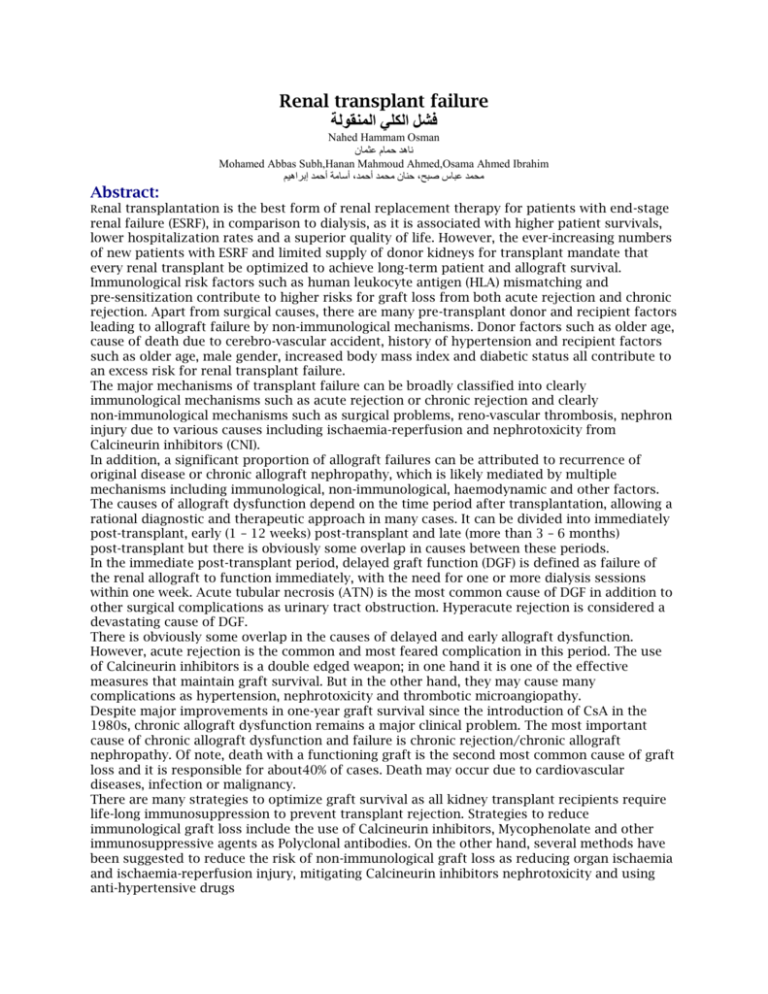
Renal transplant failure فشل الكلي المنقولة Nahed Hammam Osman ناهد حمام عثمان Mohamed Abbas Subh,Hanan Mahmoud Ahmed,Osama Ahmed Ibrahim أسامة أحمد إبراهيم، حنان محمد أحمد،محمد عباس صبح Abstract: Renal transplantation is the best form of renal replacement therapy for patients with end-stage renal failure (ESRF), in comparison to dialysis, as it is associated with higher patient survivals, lower hospitalization rates and a superior quality of life. However, the ever-increasing numbers of new patients with ESRF and limited supply of donor kidneys for transplant mandate that every renal transplant be optimized to achieve long-term patient and allograft survival. Immunological risk factors such as human leukocyte antigen (HLA) mismatching and pre-sensitization contribute to higher risks for graft loss from both acute rejection and chronic rejection. Apart from surgical causes, there are many pre-transplant donor and recipient factors leading to allograft failure by non-immunological mechanisms. Donor factors such as older age, cause of death due to cerebro-vascular accident, history of hypertension and recipient factors such as older age, male gender, increased body mass index and diabetic status all contribute to an excess risk for renal transplant failure. The major mechanisms of transplant failure can be broadly classified into clearly immunological mechanisms such as acute rejection or chronic rejection and clearly non-immunological mechanisms such as surgical problems, reno-vascular thrombosis, nephron injury due to various causes including ischaemia-reperfusion and nephrotoxicity from Calcineurin inhibitors (CNI). In addition, a significant proportion of allograft failures can be attributed to recurrence of original disease or chronic allograft nephropathy, which is likely mediated by multiple mechanisms including immunological, non-immunological, haemodynamic and other factors. The causes of allograft dysfunction depend on the time period after transplantation, allowing a rational diagnostic and therapeutic approach in many cases. It can be divided into immediately post-transplant, early (1 – 12 weeks) post-transplant and late (more than 3 – 6 months) post-transplant but there is obviously some overlap in causes between these periods. In the immediate post-transplant period, delayed graft function (DGF) is defined as failure of the renal allograft to function immediately, with the need for one or more dialysis sessions within one week. Acute tubular necrosis (ATN) is the most common cause of DGF in addition to other surgical complications as urinary tract obstruction. Hyperacute rejection is considered a devastating cause of DGF. There is obviously some overlap in the causes of delayed and early allograft dysfunction. However, acute rejection is the common and most feared complication in this period. The use of Calcineurin inhibitors is a double edged weapon; in one hand it is one of the effective measures that maintain graft survival. But in the other hand, they may cause many complications as hypertension, nephrotoxicity and thrombotic microangiopathy. Despite major improvements in one-year graft survival since the introduction of CsA in the 1980s, chronic allograft dysfunction remains a major clinical problem. The most important cause of chronic allograft dysfunction and failure is chronic rejection/chronic allograft nephropathy. Of note, death with a functioning graft is the second most common cause of graft loss and it is responsible for about40% of cases. Death may occur due to cardiovascular diseases, infection or malignancy. There are many strategies to optimize graft survival as all kidney transplant recipients require life-long immunosuppression to prevent transplant rejection. Strategies to reduce immunological graft loss include the use of Calcineurin inhibitors, Mycophenolate and other immunosuppressive agents as Polyclonal antibodies. On the other hand, several methods have been suggested to reduce the risk of non-immunological graft loss as reducing organ ischaemia and ischaemia-reperfusion injury, mitigating Calcineurin inhibitors nephrotoxicity and using anti-hypertensive drugs الملخص تعتبر زراعة الكلي أفضل طريقة من طرق العالج الكلوي اإلستيعاضي بالمقارنة بالغسيل الكلوي لمرضي المرحلة األخيرة من الفشل الكلوي حيث أنها مرتبطة بزيادة فرص شفاء المرضي و إنقاص معدل البقاء بالمستشفيات و تحسين لجودة حياة المرضي .و مع ذلك فان الزيادة المطردة في أعداد مرضي المرحلة األخيرة من الفشل .الكلوي و نقص المتبرعين لعمليات زرع الكلي يحتمان التدقيق في كل عملية زرع للكلي لتحقيق أفضل نتائج للمريض و زيادة فرص نجاح العملية و تقليل معدالت الفشل تساهم عوامل الخطورة المناعية مثل عدم توافق مستضدات كريات الدم البيضاء البشرية و حساسية ما قبل العملية في زيادة فرص فقدان الكلية المنزرعة بسبب الرفض الحاد و المزمن للكلية المنزرعة .و بعيدا عن األسباب الجراحية ,فهنالك العديد من العوامل المتعلقة بالمتبرع و المريض تؤدي إلي فشل عملية الزرع بسبب مشاكل غير مناعية .و تشمل العوامل المتعلقة بالمتبرع كبر السن و الوفاة نتيجة السكتة الدماغية و ارتفاع ضغط الدم أما العوامل المتعلقة بالمريض فتشمل السن و الجنس و زيادة .معامل كتلة الجسم و وجود مرض البول السكري ويمكن تقسيم اآللية التي يمكن أن تؤدي إلي فشل عملية زرع الكلي إلي آليات مناعية مثل الرفض الحاد والمزمن للكلية المنزرعة و آليات غير مناعية مثل المضاعفات الجراحية و السدة باألوعية الكلوية و إصابة النيفرون الناتجة عن أسباب عدة منها نقص اإلمداد الدموي -و إعادة التروية و االعتالل الكلوي الناتج عن مثبطات الكالسنيورين .و هناك عدد من حاالت فشل الكلي المنزرعة نتيجة مرض الكلي المرتجع أو اعتالل الكلي المنزرعة المزمن والذي قد ينتج عن آليات متعددة تشمل اآلليات .المناعية و الغير مناعية و عوامل أخري هناك العديد من االستراتيجيات لتحسين فرص نجاح الكلي المنزرعة حيث أن جميع المستفيدين من زرع الكلى يحتاجون إلي تثبيط للمناعة لفترات طويلة لمنع رفض الكلي المنزرعة .و تشمل تلك االستراتيجيات استخدام مثبطات الكالسنيورين و دواء الميكوفينوالت وغيرها من األدوية المثبطة للمناعة مثل استخدام األجسام المضادة .ومن ناحية أخري ,فانه هناك عدة طرق قد اقترحت للحد من المخاطر الغير مناعية لفشل الكلي المنزرعة مثل الحد من نقص توصيل الدم للكلي المنزرعة و تخفيف .االعتالل الكلوي الناتج عن مثبطات الكالسنيورين واستخدام األدوية المضادة الرتفاع ضغط الدم

